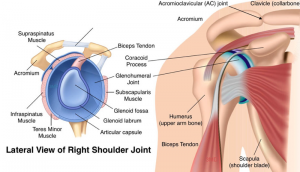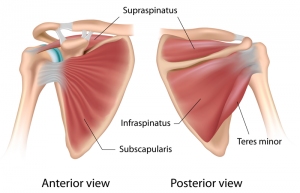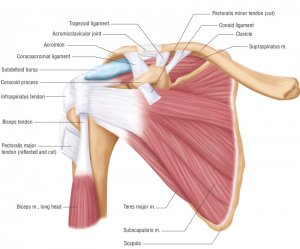- Shoulder Description
- Shoulder Pain Causes
- Shoulder Pain Treatments
- Stretching & Exercises
 The shoulder is a “ball-in-socket” joint. The upper arm bone (humerus) is held to the shoulder blade (scapula) by ligaments connecting bone to bone, and tendons connecting muscles to bone. There are many muscles that help stabilize the shoulder joint and move the arm. The shoulder joint is unique compared to other joints because it can move in many directions.
The shoulder is a “ball-in-socket” joint. The upper arm bone (humerus) is held to the shoulder blade (scapula) by ligaments connecting bone to bone, and tendons connecting muscles to bone. There are many muscles that help stabilize the shoulder joint and move the arm. The shoulder joint is unique compared to other joints because it can move in many directions.
The rotator cuff is a group of 4 muscles that mainly stabilize the shoulder joint. They are the supraspinatus, infraspinatus, subscapularis and teres minor muscles. The muscles are attached to the shoulder blade and each have a tendon that connects to the upper arm bone. The four muscles and their tendons form a cuff around the shoulder joint.
Rotator cuff

ROTATOR CUFF MUSCLES
Rotator Cuff Tendinopathy
Rotator cuff tendinopathy occurs when the tendons are injured or inflamed. The most common cause of rotator cuff tendinopathy is from consistent, repetitive use of the arm when it is outstretched or overhead. However, it can be caused by other injuries such as a fall on the shoulder. It is common in athletics such as swimming, baseball, tennis, and golf where the arm is used above the head. Also, it is a common workplace injury.
People with this condition typically have pain in the outer aspect of the shoulder and upper arm. The pain may worsen with lifting objects and moving the shoulder and may interfere with simple activities such as combing hair or brushing teeth.
Rotator Cuff Tears
Rotator cuff tears occur when a tendon is torn. The cause of a tear can be due to an injury such as a fall or a forcefull pulling or due to a longstanding rotator cuff tendinopathy. The tear can be partially or completely through the tendon.
Symptoms of rotator cuff tears are similar to tendinopathy.
Pain with movement of the shoulder is most common.
Pain may also be present at night when the person lies on the affected shoulder. Weakness of the shoulder muscles can be present.
The degree of tear does not necessarily represent the severity of the symptoms.
Shoulder Impingement
 Shoulder impingement occurs when the tendon of the supraspinatous muscle (the dominant rotator cuff muscle) and the subacromial bursa (fluid sac) are compressed by the bones of the shoulder. This compression can cause pain, limiting the movement of the shoulder – especially moving the arm away from the body.
Shoulder impingement occurs when the tendon of the supraspinatous muscle (the dominant rotator cuff muscle) and the subacromial bursa (fluid sac) are compressed by the bones of the shoulder. This compression can cause pain, limiting the movement of the shoulder – especially moving the arm away from the body.
Impingement is typically caused by repetitive movements with the arm outstretched or overhead. The symptoms can limit a person’s activity and potentially lead to other shoulder problems such as rotator cuff tendinopathy, rotator cuff tears and inflammation of the bursa.
Adhesive Capusilitis – “Frozen Shoulder”
Frozen shoulder occurs when the shoulder is no longer able to move freely. When the shoulder suffers an injury, such as a rotator cuff tendonopathy or tear, the body’s natural response to limit further injury is to not allow the joint to move. The stiff shoulder will not allow a person to reach above their head or behind their back.
Rotator Cuff Tendonitis and Tears
Treatment for tendonitis and tears are similar:
- Rest the affected shoulder. It is not recommended to put the arm in a sling because this may lead to frozen shoulder. Avoiding activities that make the pain worse such as overhead activities is important to not further aggravate the shoulder.
- Ice may be applied to the shoulder for 15 minutes, 3-4x per day to decrease the swelling.
- During the initial phase, anti-inflammatories such as ibuprofen (Advil, Motrin) or naproxen (Aleve) may be used.
- After the acute phase has subsided, physical therapy is used to help stabilize the shoulder and prevent further damage or complications.
Exercises:
- Weighted pendulum
- This exercise gently stretches the tendons and helps open the area between the bones of the shoulder. It will also help prevent complications such as frozen shoulder.
- Follow the video to view how to perform this exercise. Perform 3 cycles of this exercise, each 30 seconds in length.
- Stretching
- Stretching exercises help improve the range of motion of the shoulder and helps prevent adhesive capsulitis (“frozen shoulder”)
- Follow the video to view how to perform this exercise. Perform 10 repetitions of each exercise for 3 cycles.
- Flexion
- Abduction
- Outward rotation
- Inward rotation
- Muscle strengthening
- Strengthening exercises help improve shoulder muscle strength and improve the stability of the joint. Strengthening the muscles of the shoulder will help prevent future injury.
- Each exercise should be done 10 times for 3 cycles.
- Abduction
- Outward rotation
- Inward rotation
- Scapular strengthening
- Adduction
- Flexion
Note: any of the above exercises should not cause more than minimal pain. Should significant pain occur during exercises, you should stop and rest your shoulder. If you have any concerns, please contact your primary physician.
Shoulder Impingement
Treatment:
- Rest the affected shoulder. Limit activities that worsen the pain such as overhead reaching, reaching across the chest or outstretched arms.
- Ice applied to the shoulder for 15 minutes at time, 3-4x per day.
- Anti-inflammatories such as ibuprofen (Advil, Motrin) or naproxen (Aleve) can be used as needed. Please see medication labels for dosing and cautions.
- Stretching and exercises will help the shoulder to recover and prevent future impingement or its complications such as rotator cuff tendonitis or adhesive capsulitis (“frozen shoulder”).
Exercises:
- Weighted pendulum
- This exercise gently stretches the tendons and helps open the area between the bones of the shoulder. It will also help prevent complications such as frozen shoulder.
- Follow the video to view how to perform this exercise. Perform 3 cycles of this exercise, each 30 seconds in length.
- Stretching
- Stretching exercises help improve the range of motion of the shoulder and helps prevent adhesive capsulitis (“frozen shoulder”)
- Follow the video to view how to perform this exercise. Perform 10 repetitions of each exercise for 3 cycles.
- Flexion
- Abduction
- Outward rotation
- Inward rotation
- Muscle strengthening
- Strengthening exercises help improve shoulder muscle strength and improve the stability of the joint. Strengthening the muscles of the shoulder will help prevent future injury.
- Each exercise should be done 10 times for 3 cycles.
- Abduction
- Outward rotation
- Inward rotation
- Scapular strengthening
- Adduction
- Flexion
Note: any of the above exercises should not cause more than minimal pain. Should significant pain occur during exercises, you should stop and rest your shoulder. If you have any concerns, please contact your primary physician.
Adhesive Capsulitis
Treatment:
- Slowly increase activity levels as mobility increases and pain decreases.
- Ice may be applied to area for 15 minutes, 3-4x per day to reduce pain and inflammation.
- If needed, antiinflammatories such as ibuprofen (Advil, Motrin) or naproxen (Aleve) may be used for short intervals. Please see medication labels for dosing and cautions.
- Physical therapy is the most important treatment for frozen shoulder. The goal is to improve range of motion.
- Improvement in function may take several months.
Exercises:
- Stretching
- Stretching exercises are the most important exercises for frozen shoulder to help loosen the tighten shoulder and improve range of motion.
- Follow the video to view how to perform this exercise. Perform 10 repetitions of each exercise for 3 cycles.
- Flexion
- Abduction
- Outward rotation
- Inward rotation
Stretches & Exercises
- Weighted pendulum
- This exercise gently stretches the tendons and helps open the area between the bones of the shoulder. It will also help prevent complications such as frozen shoulder.
- Follow the video to view how to perform this exercise. Perform 3 cycles of this exercise, each 30 seconds in length.
- Stretching
- Stretching exercises help improve the range of motion of the shoulder and helps prevent adhesive capsulitis (“frozen shoulder”)
- Follow the video to view how to perform this exercise. Perform 10 repetitions of each exercise for 3 cycles.
- Flexion
- Abduction
- Outward rotation
- Inward rotation
- Muscle strengthening
- Strengthening exercises help improve shoulder muscle strength and improve the stability of the joint. Strengthening the muscles of the shoulder will help prevent future injury.
- Each exercise should be done 10 times for 3 cycles.
- Abduction
- Outward rotation
- Inward rotation
- Scapular strengthening
- Adduction
- Flexion
Note: any of the above exercises should not cause more than minimal pain. Should significant pain occur during exercises, you should stop and rest your shoulder. If you have any concerns, please contact your primary physician.
Inward Rotation